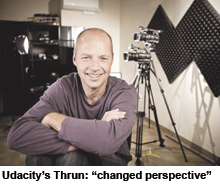Top-quality teaching, stringent admissions criteria and impressive qualifications allow the world’s best universities to charge mega fees: over $50,000 for a year of undergraduate study at Harvard. Less exalted providers have boomed too, with a similar model which sells seminars, lectures, exams and a “salad days” social life in a single bundle. Now online provision is transforming higher education, giving the best universities a chance to widen their catch, opening new opportunities for the agile, and threatening doom to the laggard and mediocre.
The roots are decades old. Britain’s Open University started teaching via radio and television in 1971; the for-profit University of Phoenix has been teaching online since 1989; MIT and others have been posting lectures on the internet for a decade. But the change in 2012 has been electrifying.
Two start-ups, both spawned by Stanford University, are recruiting students at an astonishing rate for “massive open online courses” or MOOCs. In January last year, Sebastian Thrun, a computer science professor there, announced the launch of Udacity. It started to offer courses the next month — a nanosecond by the standards of old-style university decision-making. He also gave up his Stanford tenure, saying Udacity had “completely changed my perspective”. In October Udacity raised $15 million (Rs.82 crore) from investors. It has 475,000 users.
 In April two of Thrun’s ex-colleagues, Andrew Ng and Daphne Koller, launched a rival, Coursera, with $16 million (Rs.87.5 crore) in venture capital. At first it offered online courses from four universities. By August it had signed up 1 million students, rising to over 2 million now. Its most successful class, “How to reason and argue”, attracted over 180,000 students. Harvard and MIT announced they would each put up $30 million to launch edX, a non-profit venture offering courses from Ivy League universities. Other schools have joined too.
In April two of Thrun’s ex-colleagues, Andrew Ng and Daphne Koller, launched a rival, Coursera, with $16 million (Rs.87.5 crore) in venture capital. At first it offered online courses from four universities. By August it had signed up 1 million students, rising to over 2 million now. Its most successful class, “How to reason and argue”, attracted over 180,000 students. Harvard and MIT announced they would each put up $30 million to launch edX, a non-profit venture offering courses from Ivy League universities. Other schools have joined too.
The trend stretches far beyond America. Eight among Coursera’s 33 partners are foreign, including the universities of Edinburgh, Toronto and Melbourne. On December 14, a consortium of British providers, led by the Open University and including Bristol, St. Andrews and Warwick, said Futurelearn, a new platform for free courses, will soon compete with the American newcomers.
MOOCs are more than good university lectures available online. The real innovation comes from integrating academics talking with interactive coursework, such as automated tests, quizzes and even games. Real-life lectures have no pause, rewind (or fast-forward) buttons; MOOCs let students learn at their own pace, typically with short, engaging videos, modelled on the hugely successful online lecturettes pioneered by TED, a non-profit organiser of upmarket mindfests.
The cost of the courses can be spread over huge numbers of students. An Udacity course on machine learning, taught by Peter Norvig, Google’s director of research, attracted 160,000 students. Koller of Coursera muses that a single virtual classroom may one day seat 1.5 million. Thousands of minds mingle in moderated discussion forums, where learners in Peru, Finland or Japan can speedily reply to a struggling student’s question, highlight points which are unclear, and even grade each others’ work.
MOOCs enrich education for rich-world students, especially the cash-strapped, and those dissatisfied with what their own colleges are offering. But for others, especially in poor countries, online education opens the door to yearned-for opportunities. One famous MOOC graduate is Khadijah Niazi, an 11-year-old girl in Lahore who completed Udacity’s Physics 100 class. Of the 155,000 people from five countries who registered for MIT’s prototype Circuits and Electronics course, only 45 percent were aged between 18-25. Most traffic came from five countries: America, India, Britain, Colombia and Spain. About 7,200 students cleared the course.
Some of Europe’s best schools are determinedly unruffled. Oxford says MOOCs “will not prompt it to change anything”, adding that it “does not see them as revolutionary in anything other than scale”. Cambridge even says it is “nonsense” to see MOOCs as a rival; it is “not in the business of online education”.
But elsewhere, change is likely to be more disruptive. Clayton Christensen, a Harvard Business School professor and author of The Innovative University, predicts “wholesale bankruptcies” among universities over the next decade.
(Excerpted and adapted from Times Higher Education)